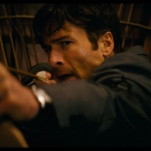Director/cinematographer Ron Fricke follows his 1992 visual excursion/high-end stoner classic Baraka with the narrative-free, lush 70mm Samsara, another documentary that travels the world in search of glorious imagery, guided by and structured around a vague spirituality. Named for the Eastern religious term for the cycle of birth, death, and reincarnation, Samsara is lightly bookended by Buddhist monks painstakingly making and later destroying a sand mandala. Between those shots are searches for the connectedness of things in everything from cathedrals to abandoned houses, from the assembly lines at massive Chinese factories to the crowds circling the Kaaba in Mecca as part of the Hajj.
Samsara is frequently cheesy in its juxtapositions and mild exoticism, but it’s awe-inspiring in equal measure. The film’s overall patchouli scent isn’t so bad as the occasional giggle-inducing clumsy gesture at profundity: Shots of sex dolls being assembled in a workshop give way to a scene of numbered Thai bar-girls dancing in bikinis, which is followed by a shot of a geisha in full makeup, a tear slowly running down her face. But cynicism doesn’t mix well with something as unguardedly sincere as Samsara, and it more than makes up for its periodic silliness with imagery that represents a particularly pure type of cinematic experience, not just because it’s free from the constraints of telling a story, but because it’s all been selected on the basis of some type of beauty.
And there are many approaches to beauty on display here: grand and intimate, classic and challenging. A montage of children being baptized, cradled in the arms of adults as their foreheads are anointed with water, is a warm, lovely series of reactions. Shaolin trainees in a giant courtyard fill the screen as they go through their choreographed exercises. Commuters file in and out of urban trains in time-lapse, clouds rush above empty landscapes and stars spin overhead, golfers flood a driving range, women in burqas in a Dubai mall wait in front of the near-nude bodies of models in a Dolce & Gabbana underwear ad. No film can possibly capture the human experience as globally and completely as Samsara attempts to, but there’s something stubbornly endearing about the way it tries and the surrender it demands, with photography so lavish and exquisitely framed, it soaks into the pores.









































